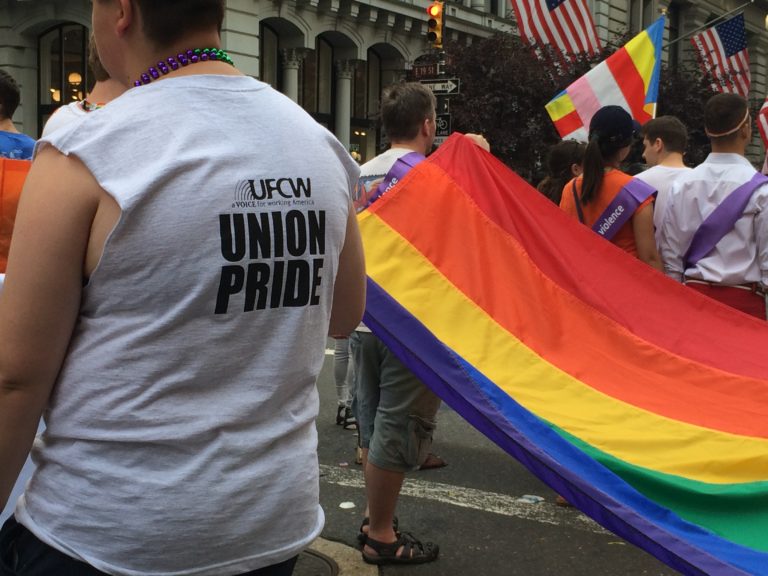
Have you ever found yourself in a position where something happened on the job that you didn’t feel was right, but didn’t feel you could do anything about it because it wasn’t technically against the law?
In 2013, more than one in five LGBT Americans told Pew researchers that they’d been mistreated by an employer because of their sexual orientation or gender identity. What most people don’t know is that in many states in the U.S. it is perfectly legal to discriminate against certain workers based on sexual orientation or gender identity.
Despite passage of legislation making same-sex marriage legal, progress on workplace discrimination laws has been slow. In many states, LGBT workers find themselves in the awkward position of having gained the right to marry the person they love, but can still be legally fired for their decision to do so.
In April, a long-overdue step forward came with a historic decision by the Seventh Circuit Court of Appeals that ruled employment discrimination on the basis of sexual orientation violates the Title VII of the Civil Rights Act of 1964. The Seventh Circuit is now the highest court in the nation to have reached this conclusion, but the ruling only applies in the 7th Circuit states of Indiana, Illinois, and Wisconsin.
The sluggish nature of the courts and the unpredictable political shifts in our elected leaders makes relying on laws alone an impractical solution to protecting the rights of all hard working men and women in any kind of lasting, meaningful way. So what are workers supposed to do?
“While this ruling is a huge step forward,” said Pride at Work Executive Director, Jerame Davis, “It is still true that the strongest, most durable protections an LGBTQ working person can obtain is an inclusive collective bargaining agreement. Union contract protections are binding to all parties regardless of federal or state law and many contracts also provide the employee with representation, something no state or federal law does.”
Instead of having to wait around for the entire country to agree on what protections you should have at work, a union contract puts the decision-making power into the hands of you and your coworkers. This has always meant more control over things like wages, scheduling, and benefits, but it also means being able to extend additional protections to vulnerable workers in your workplace.
Sample Contract Language
Each contract is different depending on what has been collectively agreed on at a given workplace or group of workplaces. So if employees decided they would like to include language to protect LGBT workers, what does that actually look like?
Below are three examples of good contract language that can be included to help protect the rights of LGBT workers and other vulnerable hard working men and women on the job.
1.) Discrimination
“The Company agrees that it will not discriminate against or treat any worker differently because of Union membership, support or activity; race, national origin, color, gender, religion or age; disability, pregnancy, or physical or mental health condition; sexual orientation, or gender identity or expression; marital or veteran status; criminal record; criminal record; or English proficiency or speaking accent.”
2.) Harassment
“The Company agrees that it will not permit harassment in the workplace. Harassment means unwelcome comments or conduct. No one at the workplace, including managers, supervisors, workers or third-parties such as vendors, consultants and independent contractors, may make comments or engage in conduct that is known to be or should reasonably be known to be unwelcome. Examples of harassment (harassment is not limited to these examples):
- If someone knows that a worker is sensitive to even mild “cuss” words, harassment would be using mild cuss words within hearing distance of the worker.
- Groping or fondling anyone.
- Showing pornographic or lewd photos, or making lewd comments.
- Making racist, sexist or homophobic comments, or negative comments about a religion.
- Making derogatory or offensive comments about someone’s appearance or background.
- Asking a worker on a date after the worker indicated that the request invitation was unwelcome.
- Deliberately or repeatedly using a name or pronoun when speaking or referring to a transgender worker other than the name the worker chose and the pronoun the worker identifies with.
- Teasing, picking on, or treating, interacting or communicating with a worker differently because of the worker’s race, national origin, color, gender, religion, age, disability, pregnancy, physical or mental health condition, sexual orientation, gender identity or expression, or gender questioning.”
3.) Transgender Workers
“If any worker is transgender, or intends to or is going through a transition in gender identity (with or without surgery or therapy):
(a) the Company and the Union will mutually agree on:
- a way to notify co-workers of the worker’s status or transition (the parties’ discussions will include the worker);
- creating safe work areas for the worker;
- designating at least one restroom as gender neutral; and
- if either party considers it advisable, developing a training for co-workers and managers, including the schedule for and frequency of the training.
(b) the Company will issue a rule:
(1) notifying all workers that transgender workers may use the restrooms and changing rooms designated for the gender they identify with; and
(2) requiring everyone at the workplace or engaged in the Company’s business to speak or refer to transgender workers by the names they choose and the pronouns they identify with.
(c) the Company will change all records so that all records use the names transgender workers choose and the pronouns they identify with, unless the worker requests the Company to refrain from changing its records. The Company will also update any photographs, including identification badges, unless the worker requests otherwise.
The Company will also administer the jointly-agreed on training for managers, supervisors and workers.”
